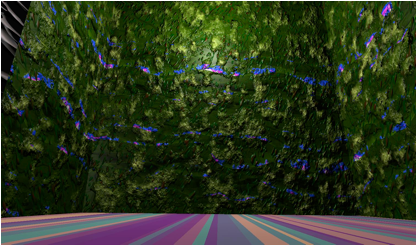There is current interest in living, for a time at least, on the surface of, say, the Moon, Mars, an asteroid, or even in the future on the surface of one of Jupiter’s Moons, Io or Europa perhaps. There are many issues, not least that of human survival in the face of high-speed cosmic particles, from which we are largely protected on Earth by our atmosphere. So, no atmosphere, or an insubstantial one, and we will need protection. And that is not easy. Then there may be volcanism, high winds, wide temperature variations, little sunlight, and almost certainly an absence of liquid water…
However, there may be one potential solution, which is to live underground, using the native rock as a (very effective) shelter. So, what would such a habitat look like, where would we site it, how would we build it—whoa! Let’s take it gently.
First let us look at a habitat concept, and then later we will examine what we would need in the way of resources, tools, facilities, energy supplies, etc., both to construct the habitat and then to maintain meaningful life.

Consider your average inhospitable surface, above. Pock marked by collisions, perhaps even prior volcanic eruptions. Does such a surface offer any support?

Well, perhaps. Here we see use being made of an old crater, into the fairly flat surface of which has been bored a vertical tunnel. A transparent dome has been placed over the top, principally to retain internal moisture and atmosphere, but also to let the occupants glimpse the outside world, should they feel the need… The dome is not used for ingress and exit, however: nor need it be illuminated, but might be covered with a representation of the surrounding regolith, so as to be virtually invisible and protected from the outside.
Ingress is via the small, lit tunnel in the foreground.

This is the point of access for vehicles or, in emergency, for people. It is small and concealed, and would not normally be lit, so that only those with a need to know would be able to find it.

The tunnel goes deep into the rock and eventually leads to a decontamination sphere, which also serves as access control.

Having been decontaminated, largely by radiation from sources set in the sphere walls, entrants then follow the small tube in front of them, which leads to the atrium under the dome.

Upon emerging into the atrium, the entrant is faced with several large passageways leading off to so-called ‘habitats:’ passageways would be blocked by airlocks and blast doors in practice—not shown above. It is within these habitats that humans will be able to live, sheltered from cosmic rays and other unpleasantness by the layer of rock above them.
First the new arrival may wish to look upwards and outwards from the atrium, where they may see a myriad of stars against a black background above them—depending on location—together with a reflection of the floor and walls from the inside of the dome. The walls of the atrium are used largely for storage, illumination and generation/purification of atmosphere, which pervades the whole, sealed, airtight complex.

Returning to the bottom of the atrium, the visitor can see down the tunnels into various habitats. There is one each for Science & Engineering, Hydroponics, Organization & Management, and Rest & Relaxation. People migrate between the various habitats by direct passageways, not shown, in the rock.There is virtually no limit to size, since digging further into the rock can expand habitats—always provided that the necessary thickness and integrity of overhead rock is maintained. Moreover, the spoil from digging provides essential minerals, building materials and, potentially, energy, too.

Of course, the tunnel doors are not normally left open, as shown. There is a need to isolate each habitat to prevent loss of atmosphere, and to pre-empt any systemic damage.
Below, the Science & Engineering Habitat is shown fitted with blast doors made from locally mined materials…

Beyond the blast doors, the Science Habitat is a series of laboratories and experimental areas, set up as needed to exploit, and survive on, the respective planet/moon/asteroid. See below…

Food and water are going to be of primary concern. Next is shown the Hydroponics Hall, where walls and ceiling are shown festooned with greenery, hidden within which are micro bore irrigation tubes carrying waterborne nutrients. Much of the food and drink is sourced from this habitat, but each of the other habitats has a smaller hydroponics section of its own, to maintain a sensible backup should one ever be needed.

Last, but far from least, comes the living quarters, which comprise a number of low-rise apartments set around the R&R chamber, with living spaces, meeting rooms, gymnasia, entertainment centres, etc. Each living room is provided with an electronic “outside wall” on which may be shown the view above ground, or any view that the occupants wish to show, such as a favourite sylvan scene on Earth. It’s not home, but…

I have rather skipped over a few essentials. Where did the water come from? How were the habitats dug? But then, you wouldn’t want me to solve every little problem…
So, what would we need to create such a home from home?
- Boring, mining and construction equipment, including forging and smelting facilities
- Copious energy supplies for construction, lighting, science research and engineering, hydroponics, entertainment,
- Water and water recycling facilities
- Rock that would stand being bored and dug out to create caverns without caving in—which was partly why, in the concept above, a crater was used on the presumption that it had volcanic origins and the volcano core would provide such a sound base. Rock faces would have to be sealed to prevent ingress and egress of gases, vapours and liquids…
So, what have we learned from the exercise? Well, I for one think the concept would, if realized, create a rather grim lifestyle for, perhaps, hundreds of people and would undoubtedly be secure, but very expensive both to create and maintain. Unless, of course, we found some way of creating the underground systems automatically, or by remote control, using the natural resources of the locale…Or if, perhaps, we were able to find naturally occurring underground caverns…
Then again, it might be practicable to have under-surface sealed spaces created remotely using, e.g., a thermonuclear discharge which would created space and seal its walls at the same time.
Well, you never know…
Derek Hitchins



